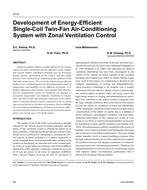In order to characterize the resistor network that describes convective heat transfer on the indoor side of a complex fenestration system, threeconvection coefficients are needed. Although methods to obtain convection coefficients in glazing cavities are well established, the convectioncoefficients in the vicinity of an indoor-mounted attachment are not so readily available. In principle, convection coefficients of a three-resistornetwork cannot be obtained based on numerical solutions or measurement only. The ASHWAT models for simulating windows with attachmentscurrently provide estimates of the three convection coefficients as functions of glass-to-shade spacing, based largely on known limits. Recently, anumerical technique, dubbed dQdT, was developed for evaluating the heat transfer coefficients of multi-temperature convection problems. Thistechnique entails numerical solutions of the full set of governing equations and subsequent solutions of the energy equation with perturbed boundaryconditions. In earlier work, dQdT was applied to a fenestration system with an indoor-mounted roller blind. To keep the flow laminar and thenumerical solutions simple, a relatively short window was considered. Preliminary results suggested that ASHWAT gives good estimates of theconvection coefficients and accurately predicts the general trends. Nevertheless, ASHWAT overestimated the glass-to-shade heat transfer coefficientfor intermediate spacing, while underpredicting glass-to-air and shade-to-air heat transfer coefficients for larger spacings. The effect of spacing alsoseemed to be underestimated by ASHWAT. The present study was undertaken to further examine the accuracy of the ASHWAT estimates forwindows with realistic dimensions, various glazing-attachment spacings and taking into account the transition of the flow to turbulence. Excellentagreement between the dQdT results and the ASHWAT predictions was obtained under summer design conditions, confirming the validity andutility of the current ASHWAT correlations. A minor adjustment to improve the accuracy of the current ASHWAT estimates is suggested.
Citation: 2017 Winter Conference, Las Vegas, NV, Conference Papers
Product Details
- Published:
- 2017
- Number of Pages:
- 8
- Units of Measure:
- Dual
- File Size:
- 1 file , 1.5 MB
- Product Code(s):
- D-LV-17-C080


